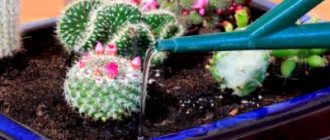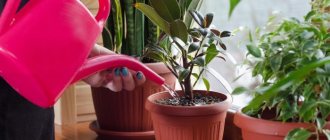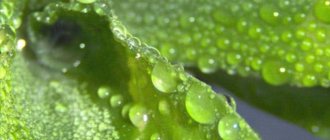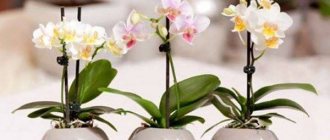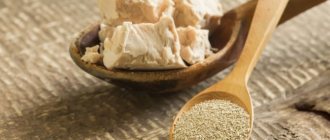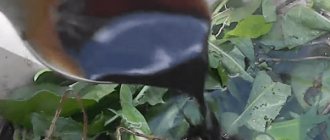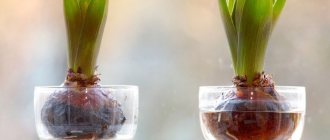In the Middle Ages, it was common to sprinkle your gardens with holy water. In those days, livelihoods directly depended on the harvest; lack of rain or early frosts had devastating consequences, so farmers approached this action with special thoughts. The use of holy water to bless and consecrate plants gave the congregation confidence in God's grace. What is it now allowed to do with holy water?
- The use of water in church services
- What is the difference between holy water and ordinary water?
- How else can you use holy water?
- Is it possible to give water special powers?
- How to properly store blessed water
- Where to put old holy water
How to use holy water from last year
Holy water does not lose its beneficial power for a long time, and there is no reason to get rid of it. If the liquid has not spoiled, become cloudy or acquired a foul odor, then the water is calmly consumed internally for any need with prayer and reverence, and in emergency cases - daily. We must remember that holy water is a gift that is accepted with gratitude.
How to drink holy water correctly?
But if for some reason a person is afraid to consume precious moisture, then recommendations for using old consecrated water will help:
- Washing. Wipe your face with a small amount of water, preventing the liquid from entering the wastewater. The effects of agiasma are especially beneficial for sick and restless young children. It is not necessary to wipe your face; you just need to let the drops dry.
- Bathing. The Church does not forbid taking a bath with the addition of holy liquid only in exceptional cases, for sick and exhausted people, and only with the permission of the clergyman. For people who are healthy in spirit and body, it is enough to wipe their torso with their palms soaked in holy water after bathing in ordinary water.
- Last year's liquid can be poured over flowers. Sprinkling the bed and food of a sick person, wetting compresses and applying to places affected by illnesses.
- Use when watering indoor plants.
- Cross-shaped sprinkling of living and working premises, personal belongings or a car, accompanied by the reading of a prayer.
- Cleansing the home from negativity or in case of frequent quarrels among household members, combining agiasma, a church candle and saying a prayer.
- Sprinkling pets, protecting them from diseases with prayers. You should not give liquid to pets to drink; the animal will not be able to perceive water as a shrine.
- Anointing with water before making an important decision.
You should not collect blessed water for future use. You can always collect godly liquid at the nearest temple on any day.
[1]
We collect consecrated baptism water correctly
If you decide to draw Epiphany water, then you must follow the following rules during this procedure:
- For this purpose, choose clean glassware without stickers.
- There is no need to pour too much water into the vessel. If you collect it for future use, it is considered a “shrine imprisonment” (without use) and will not act as it should.
- When receiving and transferring Epiphany water, you must not quarrel or use foul language.
This water is not used for various rituals and fortune telling. To preserve the miraculous properties of the liquid, you need to tighten the lid of the vessel tightly and store it next to the icons away from sunlight.
Archimandrite Spiridon (Khodanich) on the rules for storing Epiphany water:
Every pious Christian tries to save Epiphany water throughout the year, drinking it on an empty stomach, and there is no need to collect a huge amount: you can add a little consecrated water to a large container, and all the water becomes Epiphany under the influence of grace.
In case of illness, you must drink holy Epiphany water with prayer.
Epiphany water has the name “Great Agiasma”, which means “great shrine”, and you need to treat it accordingly - with reverence.
It is recommended to store Epiphany water in glass containers, in a place protected from light. The best place is in front of the home iconostasis. There is no need to put it in the refrigerator.
It is also unacceptable for holy water to get into the drain. It is unacceptable to keep water “in reserve” forever if it was brought from the temple once for Epiphany according to the principle “so that it is in the house, because everyone has it.” This is a kind of imprisonment of the shrine.
The grace of holy water does not decrease, no matter how long it is stored, but people who do not turn to the shrine are robbing themselves. It is best not to store water, but to share it with loved ones, neighbors and friends.
#MIRACLE WATER FOR WATERING HOUSE PLANTS
Show description HELLO. It has been experimentally established that, as ice slowly freezes, it intensively captures impurities at the beginning and end of freezing. Therefore, when receiving ice, it is necessary to discard the first pieces of ice that have formed, and then, after freezing the main part of the water, drain off the unfrozen residues containing impurities. Not even the most advanced filter allows you to maximally purify water from harmful impurities, much less remove deuterium from water in the form of heavy water, but the technique of preparing melt water allows you to do this.
Video taken from channel: Assorted Flowers
Where can I pour it?
It is better to store the shrine next to the icons. The vessel with holy water is stored in a dark place, next to home icons. With respect, water retains its healing properties for a long time.
But if stored incorrectly, water can lose freshness and spoil (we described the reasons for this here). In this case, it would be correct to pour out last year’s water. However, there are certain places where liquid can be disposed of and where it should not be poured. Acceptable locations include:
- An untrodden place. It is allowed to use any piece of land where no person walks or where stray animals do not run.
- Open water. The best solution is to pour old holy water into a river or stream with a current.
- Dry well or drainage system at the temple. Draining is carried out with the permission of the priest.
It is considered unacceptable for consecrated moisture to come into contact with sewage - a sewer drain or a cesspool. Pouring liquid into a sink or toilet is considered extreme disrespect for something sacred.
When pouring water, you need to say words of gratitude for the time it was in the house.
[2]
For many centuries, holy water has given hope to praying people, strengthened faith and given strength. The healing properties are accepted and approved by the Church. A respectful attitude towards agiasma gives it great power, and it, in turn, helps in family and everyday situations.
What to do with unused
Where is holy water poured? Sometimes it happens that consecrated water has spoiled, and a person is afraid to drink it internally. Then the remaining water is poured into a place far from sewage. You can’t pour it onto a path where people or animals walk, or into a sewer! This is extreme disrespect for the shrine. An acceptable place for draining unsuitable moisture is a river with a current, an open reservoir, a tree at a temple, or indoor plants.
The blessing of water is a great sacrament. It makes it possible to return to pristine purity and get closer to the Lord. Using holy water a person heals his soul and body.
What to do with old holy water?
Is it permissible to place a container of Epiphany water on the floor?
Blessed water is sacred, just like other church paraphernalia, it must be respected. Sinners walk on the floor or on the ground. Therefore, it is not recommended to place a container of water on the floor, so as not to desecrate the shrine. Otherwise, the healing properties will be lost.
Before you put Epiphany water into a vessel, you need to first think about where to put it after returning home. Only in the temple can you put the bottle on the floor. In other places it is not recommended to do this, and if you have to, it won’t be for long.
Space is to blame for everything...
Scientist Mikhail Vasilyevich Kurik (Ukraine), who was engaged in research on the state and properties of water, found out why it is on the Epiphany holiday that water becomes holy or bioactive, as scientists call it. The scientist decided to conduct an experiment: starting from December 22 and until the feast of Epiphany, he took water samples every day and observed how the structure changed and what happened to the liquid. As a result, Mikhail Vasilyevich concluded that water becomes unique due to the special influence of the energy fields of the Sun, Moon and planet Earth, as well as cosmic radiation and energy fields of other celestial bodies of the Solar system. Thus, the scientist was able to explain the unique properties of holy water from the point of view of the laws of nature.
The fact is that every year on the same day, January 19, our planet, together with the entire solar system, crosses the field of influence of special rays, a change in the gravitational fields in the space of the entire Galaxy occurs, as a result of which the bioenergy of water on Earth increases.
Research on holy water was also carried out by scientist Anton Belsky (Russia), who for a number of years on the eve of January 19 recorded active bursts of neutron flux in outer space - they exceeded background levels by more than 100 times! The maximum level of surges occurred from January 17 to 19 in different years. As a result of these influences, water is purified and charged with positive energy.
Is it possible to take medications with Epiphany water?
Many believers think that if they drink medicine with consecrated liquid, it will enhance the effect of the medicine, which will lead to a quick cure.
The clergy do not prohibit taking tablets with Epiphany water, but they also do not give a positive answer to this.
If at the time of taking the tablets the parishioner does not have plain water on hand, he can wash them down with consecrated liquid. However, in other situations it is better to refrain from this.
Is it possible to wash your face with holy water?
You can wash your face with holy water - that is, take a little into your palm and wipe your face. But there is no need to wash your face with holy water, as if it were water in a washbasin, splash it in all directions and pour the excess into the sink. This is a shrine, and it should be treated with care.
We need to wash ourselves with holy water not in order, for example, to “remove damage” (as people sometimes think), but in order to come into contact with the source of God’s grace given to us.
Is it possible to wash a child with holy water?
You can wash your child with holy water by gently rubbing a small amount over his face. But this should be done not “from the evil eye,” as parents sometimes think, but with faith that holy water gives us the opportunity to come into contact with God’s grace.
Is it possible to wash an unbaptized person with holy water?
It is possible to wash an unbaptized person with holy water. Anyone who believes in its beneficial effects, but who does not treat holy water as some kind of amulet, can drink or anoint themselves with holy water. Holy water is not a magical medicine, but a shrine, which, if a person himself strives for God, can give him some support on this path.
Rules for watering flowers
Plants, especially indoor flowers, need regular watering. But he shouldn’t be thoughtless - the wrong amount of water can kill your green friend. The instructions below will tell you how to properly water flowers.
Step 1. For quality watering, the plants must be planted correctly. Be sure to take a pot with drainage holes at the bottom so that excess moisture can flow out of it.
Step 2. Use loose and light soil, selected for a specific type of plant. Before planting the flower, add some drainage material, such as expanded clay, to the bottom of the pot.
On a note! The pot doesn't have to be big! When replanting, use a container only 5 cm wider than the previous pot.
Step 3. Water indoor plants only as needed and as recommended in the flower description. Don't adjust watering to fit your schedule, but adapt it to the needs of the plants. Be sure to take into account seasonality and climatic conditions.
Step 4. The soil and appearance of the plants will help you determine the need for watering. Feel the soil and look at the tray under the pot - if there is water in it, then you are watering too intensely.
Step 5. If you notice signs of wilting in the plant or see yellowed leaves, then it clearly does not have enough moisture.
Step 6. Feel the soil, plunge your finger into it to a depth of about 2-2.5 cm. The soil can be dry, wet or damp. In the first case, the flower needs water.
Step 7. If the soil feels damp to the touch, but the flower clearly feels unwell, then most likely you flood it. Reduce watering immediately. If the soil is dry and the plant feels great, then look through a guide to indoor flowers - maybe this flower does not need constantly moist soil.
Step 8. Water the flowers until fresh water begins to flow into the tray. After watering, pour out excess moisture from it. If the soil is dry, water the plant by submersion (immerse the pot in a basin of water for an hour).
On a note! Water your indoor plants only with settled water at room temperature. Ideally, you should use melt or rain water. Also, when watering, always direct the stream at the root, and not at the leaves or buds.
Video - How to water flowers
Soil prices
Epiphany water and animals
Scripture says that animals should not touch holy water. Therefore, people should not give this type of water to their pets. The exception is when the pet is facing a dangerous disease and the owner hopes that the shrine will help in this case. A few drops of consecrated water are added to the animal’s drink. Only the faith of the pet owner will definitely help here.
How is holy water used?
Christians can use holy water in several ways and for several purposes. It is advised to drink it a little every morning after prayer during illness. She is also regularly sprinkled on the house, food, and various objects, such as icons. You should only collect water for Epiphany in clean jars so that no debris or dirt gets into it. Holy water should be stored at home in the Red Corner next to the icons. And on the lid you can write the year when it was collected. It is customary to share excess water with family and friends who, for some reason, were unable to collect it themselves - in this case, there is no need to skimp.
Since holy water does not spoil, it can last for more than one year. But many do not dare to drink it and do not even use last year’s drink. At the same time, under no circumstances should old water be poured into the toilet, sink, or thrown out onto the street. In this regard, many try to use it for other good purposes - for example, sprinkling pets or watering flowers.

